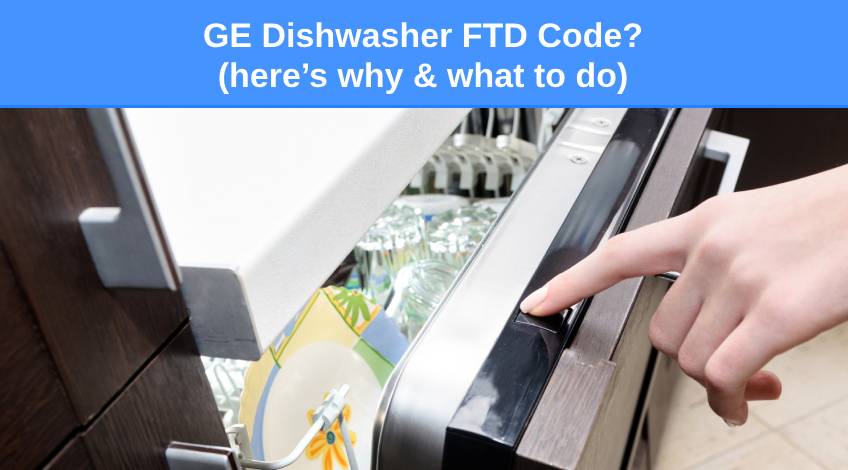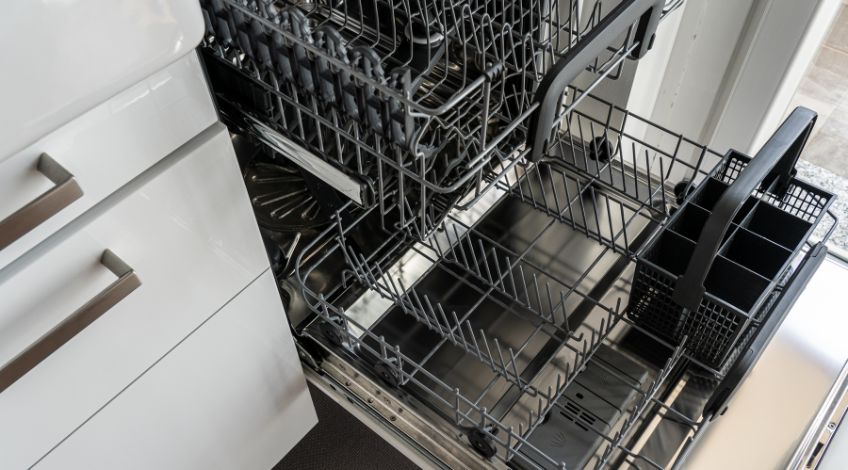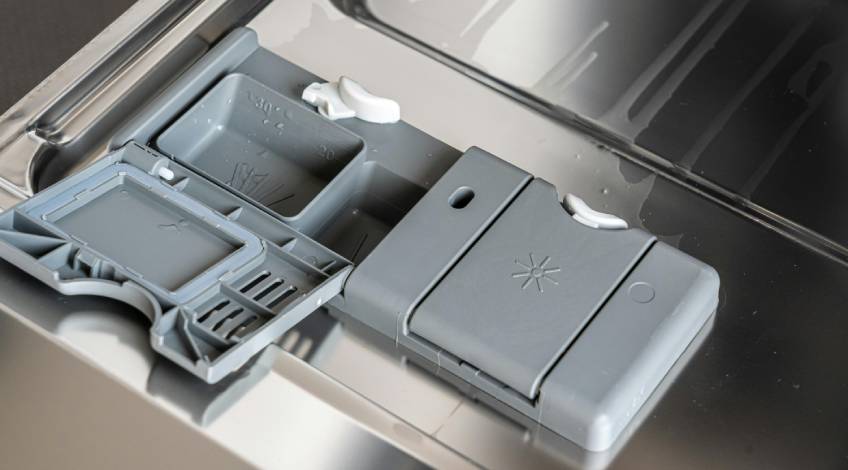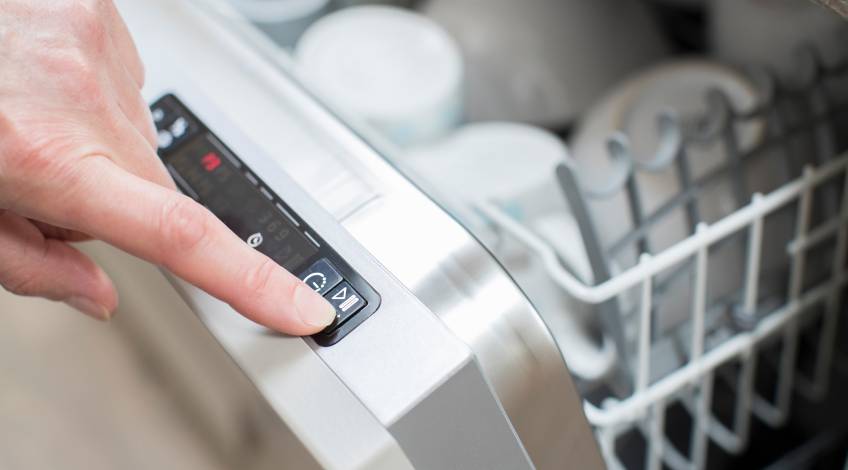
GE Dishwasher FTD Code? (here’s why & what to do)
If you own a dishwasher and it fails to work correctly it can be worrying. Especially if you have no indication of what’s causing the problem.
If you own a General Electric dishwasher you’re in luck, because their appliances produce error codes that tell you exactly what’s gone wrong. This makes fixing any problems so much easier.
In this article we take a look at the GE dishwasher error code FTD. We explain what it means, what’s likely to have caused it to be displayed and more importantly, offer ways to solve it.
What Does The FTD Error Code Mean On A GE Dishwasher?
FTD on a GE dishwasher means Failure To Drain and it’s most likely to be displayed when your GE dishwasher’s drainage system fails to remove wastewater during a cycle.
There are several reasons for this which we will look into below.
What Causes The FTD Error Code?
The FTD error code on a GE dishwasher can be caused by any of the following;
| Probable Cause | Solution |
|---|---|
| Twisted Or Clogged Drain Hose | Straighten and unblock the drain hose |
| Clogged Filter | Remove and clean the filter |
| Blocked Waste Disposal Unit | Unblock the waste disposal unit |
| Blocked Air Gap | Clear the air gap |
| Blocked Sink Waste Pipe | Unblock the sink waste pipe |
| Using Too Much Or The Incorrect Type Of Detergent | Ensure you use the correct type and quantity of detergent |
| Defective Pressure Sensor | Inspect and replace the pressure sensor if necessary |
| Defective Drain Pump | Inspect and replace the drain pump if necessary |
| Clogged Chopper Blade | Clear any blockage or replace the chopper blade |
| Control Board Malfunction | Perform a reset. contact a technician |
Let’s take a closer look at each of these issues;
Twisted Or Clogged Drain Hose

All of the wastewater that leaves the dishwasher travels through the drain hose. If this is twisted or kinked or has any type of blockage, the wastewater will not be able to leave the dishwasher and will back up.
This will trigger the FTD error code and the appliance will shut down. You will need to inspect the drain hose and straighten any twists or kinks and remove any blockages.
If you’re sure there is a blockage in the drain hose you can try to remove it by pouring 1 cup of white vinegar and 1 cup of bicarbonate of soda into the tub and let it work for around 30 minutes. After 30 minutes or so, check to see if the water has gone from inside the tub of the appliance.
If it has, run a short cycle to remove any remaining sludge. If the water is still there, you will need to remove it as best as you can and then run a plumber’s snake into the drain hose to clear any blockage.
How To Remove Standing Water From The Tub Of Your Dishwasher
We have found 2 effective ways to remove standing water from the tub of a dishwasher which are;
- Using A Jug
Simply scoop as much water as possible from the base of the tub using a jug or cup. The last remnants can be soaked up using a towel or absorbent cloth. - Using A Wet/Dry Vacuum
After fitting the wet filter on your wet/dry vacuum, simply vacuum all of the water from the base of the tub.
We have found that the jug method works best for smaller amounts of standing water and the wet/dry vacuum is better for larger amounts.
Clogged Filter

The filter on your dishwasher is designed to trap all food particles and other debris and prevent them from clogging internal components as well as preventing any debris from returning to the now clean dishes.
If the filter becomes clogged it will hinder the flow of wastewater and trigger the FTD error code.
You will need to consult your user manual for the precise location of your GE dishwasher’s filter along with the correct way to remove it. Once removed, you should wash the filter in warm soapy water to remove any food waste or other debris.
Stubborn stains can be removed using a toothbrush or similar soft brush and really stubborn stains can be removed by soaking the filter in a 50/50 solution of warm water and white vinegar.
Blocked Waste Disposal Unit
If your dishwasher is connected to a waste disposal unit, the unit can become blocked which would prevent the dishwasher from draining properly and trigger the FTD error code.
Try running the waste disposal for 30 seconds or so to see if it clears it. Many can be operated manually if the unit won’t run due to a blockage.
This usually involves using an allen key to manually turn the blades inside the unit.
Blocked Air Gap
If your dishwasher is connected to an air gap, this could become blocked which would also trigger the FTD error code. You will need to inspect the air gap by removing the cover and cap and removing any blockage with a pair of tweezers.
Any residual food waste or debris can be removed using a bottle brush before replacing the cap and cover.
Blocked Sink Waste Pipe

If your dishwasher is connected directly to the kitchen sink waste pipe, it is possible that this has become blocked. There would usually be some evidence of a blockage seen in the actual sink but not always.
You can try to clear any blockage using a plunger, plumber’s snake or drain cleaner.
Using Too Much Or The Incorrect Type Of Detergent

Using too much detergent in your dishwasher can lead to the production of too many soap suds which the dishwasher struggles to clear. This would lead to the FTD error code being displayed.
This can also occur if you use the wrong type of detergent in your dishwasher, washing up liquid for example. If you do find that the dishwasher has produced too many soap suds, try placing a bowl of milk on the upper rack and running a short wash cycle.
The soap suds will bind with the fat content in the milk and drain away.
Defective Pressure Sensor
The pressure sensor is designed to signal the control board when there is sufficient water in the tub to wash the dishes. It is a sensitive piece of kit which can easily become defective if, for example food waste, debris or limescale were to build up around the sensor.
This could all lead to the FTD error code being triggered. You can often clean around the sensor with a soft cloth but take care, it is sensitive and will get damaged easily.
If it proves to be faulty, we recommend contacting a technician to replace the sensor for you.
Defective Drain Pump
The drain pump powers the impeller which forces all of the wastewater from the appliance. If the drain pump develops a fault, the wastewater won’t leave the dishwasher triggering the FTD error code.
It could be something as simple as the impeller blades are blocked with food waste or debris which is preventing them from turning properly. This can be solved by accessing the drain pump and freeing any blockage.
However, it could also be a part of the drain pump has become defective due to old age or wear and tear. We recommend getting a technician to investigate and replace the drain pump if necessary.
Clogged Chopper Blade
If your GE dishwasher is fitted with a chopper blade it could become clogged with food particles or other debris. The chopper blade is typically located within the dishwasher’s pump.
This means in most cases that you will need to remove the lower spray arm and lower rack to access it. You will then need to remove the chopper cover by removing the screws holding it in place.
You will then be able to see any blockages or debris causing it to clog. You can then clean the chopper blades and reassemble the unit. However, if this is a step too far, we recommend contacting a technician to do this for you.
Control Board Malfunction

The control board manages every process on your dishwasher. It is susceptible to faults including software glitches as well as physical faults like shorts or burnt out connectors.
How To Reset Your Dishwasher
If you believe the problem is due to a glitch you can reset the appliance by simply pressing the start/reset button and waiting for 2 minutes.
If this doesn’t work, you should disconnect the power supply for 10 to 15 minutes to allow any residual power to dissipate. When you reconnect the power, the FTD error code should have cleared.
If it returns shortly afterwards or doesn’t clear at all, it could be that the control board is faulty and will need replacing. We recommend contacting a technician to investigate further and replacing the control board if necessary.
Ways To Prevent The FTD Error Code From Appearing
Once you have successfully removed the FTD error code from your dishwasher, it’s a good idea to try to prevent it from happening again. By following the list below you can help to prevent your dishwasher from displaying the FTD error code. You should;
- Scrape dishes before stacking them in the dishwasher
- Inspect the drain hose for any twists or kinks regularly
- Clean the dishwasher’s filter at least once a month
- Run a hot service wash at least once a month to prevent any buildup of detergent, food waste, debris or limescale
SEE ALSO: How to Reset a GE Dishwasher (easiest way)
Frequently Asked Questions
The FTD error code on a GE dishwasher means Failure To Drain and is displayed when the dishwasher cannot remove wastewater.
You can sometimes clear an error code from your GE dishwasher by pressing the start/reset button and waiting 2 minutes. If this fails to work, disconnect the power supply for 10 to 15 minutes to allow any residual power to dissipate. On restoring the power, the error code should be gone. If it remains or returns soon afterwards, you will need to get your dishwasher checked out by a technician.
If your GE dishwasher isn’t draining it could be because; the drain hose is twisted or blocked, the filter is clogged, the waste disposal unit, air gap or sink waste pipe are blocked, you have used too much or the wrong type of detergent, the pressure sensor is defective, the drain pump is faulty, the chopper blade is clogged or the control board is defective.
Also, follow us on Pinterest ...



